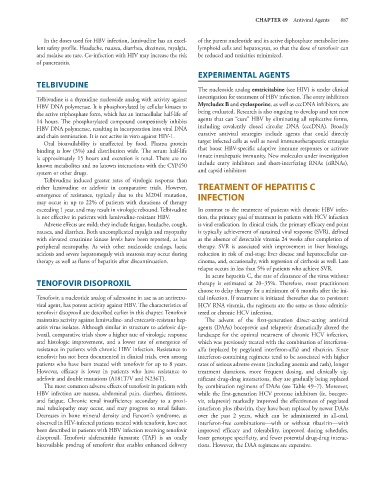Page 901 - Basic _ Clinical Pharmacology ( PDFDrive )
P. 901
CHAPTER 49 Antiviral Agents 887
In the doses used for HBV infection, lamivudine has an excel- of the parent nucleotide and its active diphosphate metabolite into
lent safety profile. Headache, nausea, diarrhea, dizziness, myalgia, lymphoid cells and hepatocytes, so that the dose of tenofovir can
and malaise are rare. Co-infection with HIV may increase the risk be reduced and toxicities minimized.
of pancreatitis.
EXPERIMENTAL AGENTS
TELBIVUDINE
The nucleoside analog emtricitabine (see HIV) is under clinical
Telbivudine is a thymidine nucleoside analog with activity against investigation for treatment of HBV infection. The entry inhibitors
HBV DNA polymerase. It is phosphorylated by cellular kinases to Myrcludex B and cyclosporine, as well as cccDNA inhibitors, are
the active triphosphate form, which has an intracellular half-life of being evaluated. Research is also ongoing to develop and test new
14 hours. The phosphorylated compound competitively inhibits agents that can “cure” HBV by eliminating all replicative forms,
HBV DNA polymerase, resulting in incorporation into viral DNA including covalently closed circular DNA (cccDNA). Broadly
and chain termination. It is not active in vitro against HIV-1. curative antiviral strategies include agents that could directly
Oral bioavailability is unaffected by food. Plasma protein target infected cells as well as novel immunotherapeutic strategies
binding is low (3%) and distribution wide. The serum half-life that boost HBV-specific adaptive immune responses or activate
is approximately 15 hours and excretion is renal. There are no innate intrahepatic immunity. New molecules under investigation
known metabolites and no known interactions with the CYP450 include entry inhibitors and short-interfering RNAs (siRNAs),
system or other drugs. and capsid inhibitors
Telbivudine induced greater rates of virologic response than
either lamivudine or adefovir in comparative trials. However, TREATMENT OF HEPATITIS C
emergence of resistance, typically due to the M204I mutation, INFECTION
may occur in up to 22% of patients with durations of therapy
exceeding 1 year, and may result in virologic rebound. Telbivudine In contrast to the treatment of patients with chronic HBV infec-
is not effective in patients with lamivudine-resistant HBV. tion, the primary goal of treatment in patients with HCV infection
Adverse effects are mild; they include fatigue, headache, cough, is viral eradication. In clinical trials, the primary efficacy end point
nausea, and diarrhea. Both uncomplicated myalgia and myopathy is typically achievement of sustained viral response (SVR), defined
with elevated creatinine kinase levels have been reported, as has as the absence of detectable viremia 24 weeks after completion of
peripheral neuropathy. As with other nucleoside analogs, lactic therapy. SVR is associated with improvement in liver histology,
acidosis and severe hepatomegaly with steatosis may occur during reduction in risk of end-stage liver disease and hepatocellular car-
therapy as well as flares of hepatitis after discontinuation. cinoma, and, occasionally, with regression of cirrhosis as well. Late
relapse occurs in less than 5% of patients who achieve SVR.
In acute hepatitis C, the rate of clearance of the virus without
TENOFOVIR DISOPROXIL therapy is estimated at 20–35%. Therefore, most practitioners
choose to delay therapy for a minimum of 6 months after the ini-
Tenofovir, a nucleotide analog of adenosine in use as an antiretro- tial infection. If treatment is initiated thereafter due to persistent
viral agent, has potent activity against HBV. The characteristics of HCV RNA viremia, the regimens are the same as those adminis-
tenofovir disoproxil are described earlier in this chapter. Tenofovir tered or chronic HCV infection.
maintains activity against lamivudine- and entecavir-resistant hep- The advent of the first-generation direct-acting antiviral
atitis virus isolates. Although similar in structure to adefovir dip- agents (DAAs) boceprevir and telaprevir dramatically altered the
ivoxil, comparative trials show a higher rate of virologic response landscape for the optimal treatment of chronic HCV infection,
and histologic improvement, and a lower rate of emergence of which was previously treated with the combination of interferon-
resistance in patients with chronic HBV infection. Resistance to alfa (replaced by pegylated interferon-alfa) and ribavirin. Since
tenofovir has not been documented in clinical trials, even among interferon-containing regimens tend to be associated with higher
patients who have been treated with tenofovir for up to 8 years. rates of serious adverse events (including anemia and rash), longer
However, efficacy is lower in patients who have resistance to treatment durations, more frequent dosing, and clinically sig-
adefovir and double mutations (A181T/V and N236T). nificant drug-drug interactions, they are gradually being replaced
The most common adverse effects of tenofovir in patients with by combination regimens of DAAs (see Table 49–7). Moreover,
HBV infection are nausea, abdominal pain, diarrhea, dizziness, while the first-generation HCV protease inhibitors (ie, bocepre-
and fatigue. Chronic renal insufficiency secondary to a proxi- vir, telaprevir) markedly improved the effectiveness of pegylated
mal tubulopathy may occur, and may progress to renal failure. interferon plus ribavirin, they have been replaced by newer DAAs
Decreases in bone mineral density and Fanconi’s syndrome, as over the past 2 years, which can be administered in all-oral,
observed in HIV-infected patients treated with tenofovir, have not interferon-free combinations—with or without ribavirin—with
been described in patients with HBV infection receiving tenofovir improved efficacy and tolerability, improved dosing schedules,
disoproxil. Tenofovir alafenamide fumarate (TAF) is an orally lesser genotype specificity, and fewer potential drug-drug interac-
bioavailable prodrug of tenofovir that enables enhanced delivery tions. However, the DAA regimens are expensive.

